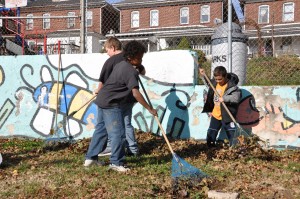Strengthening Community Connections: Green Investment in the West Ward of Easton: Spring’10-Fall’10
Client: West Ward Neighborhood Partnership
 This project is part of an ongoing and continuous process to revitalize the West Ward of Easton, PA. Through the Wachovia Regional Foundation, the West Ward Neighborhood Partnership and the Community Action Committee of the Lehigh Valley (CACLV), the Technology Clinic is working to make the West Ward a safer, healthier, and happier place. This project hopes to generate a greater sense of pride within the community and increase participation among West Ward citizens.
This project is part of an ongoing and continuous process to revitalize the West Ward of Easton, PA. Through the Wachovia Regional Foundation, the West Ward Neighborhood Partnership and the Community Action Committee of the Lehigh Valley (CACLV), the Technology Clinic is working to make the West Ward a safer, healthier, and happier place. This project hopes to generate a greater sense of pride within the community and increase participation among West Ward citizens.
Identification of Objectives:
In trying to make the West Ward “the greenest little neighborhood in Pennsylvania,” it became clear that there was a need to focus on a specific aspect of the Ward that would influence as many people as possible. This project has worked to generate ideas to facilitate a greater sense of pride within the community and to increase participation among West Ward citizens in neighborhood activities.
Theories of Development:
In order to develop the objectives identified by the Lafayette College Technology Clinic, two cornerstones of development have been identified that should be adhered to:
1) Urban Ecology is a subfield of ecology that focuses upon the interactions of organisms in urban settings, specifically those of the community at large, and nature.
2) Identifying and connecting gathering places in order to help area residents transform a commonly-overlooked area into a vital space that highlights local assets and serve common needs.
Processes: The following four processes must occur in order to facilitate the revitalization of the West Ward:
Bridging of Locations
Eco-friendly Land Use
Canvassing the Community for Resident Input
Organizing Gathering Events
Results: Raspberry Park, located at Raspberry Street between Ferry Street and Spruce Street, proved to be an ideal juncture in which the surrounding community could be aided to help improve an established gathering location for children and adults alike.
Recommendation: Create an urban exercise trail along the West Ward’s streets and alleyways in order to connect additional community gathering locations, such as the Easton Area Community Center and Centennial Park, to spur economic activity, and foster community involvement.
Students: Justin Barry’12, Hannah Klein’11, James Maloney’12, Martin Melendro’11, Kelley Reslewic’12, Christopher Vecchio’11
Faculty Facilitators: Dan Bauer & Lawrence Malinconico